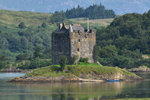History
Kilchurn Castle was built in the mid-1400s by Colin Campbell of Glenorchy, 1st Earl of Breadalbane, and resides on the banks of Loch Awe in Argyll and Bute, Scotland. Colin's father, Duncan Campbell, had offered him the lands of Glen Orchy in 1432 to ensure his loyalty following the sudden death of his brother. The Campbells of Glenorchy would become the most powerful junior branch of the Clan Campbell and reside at Kilchurn Castle for about 150 years.

The existence of Kilchurn Castle was first mentioned in a charter dated March 1449 entitled "apud Castrum de Glenurquhay" (at the Castle of Glenurquhay). The original castle comprised a five-story (four-story and a garret) tower house and a courtyard. The tower house contained a hall, private chambers, a cellar, and a prison. Colin's son, Sir Duncan Campbell of Glenorchy, added the laich hall, or dining hall, along the south curtain wall in the courtyard before he died at the Battle of Flodden in 1513. Sir Colin Campbell, the 6th Lord, added chambers to the north of the tower house and circular corner turrets adorned by corbels in the second half of the 16th century. Colin also built Balloch Castle, now Taymouth Castle by Loch Tay.
In 1614, Sir Duncan Campbell, "Black Duncan," rebuilt the south range of the castle and constructed a new range, which included the chapel in the southeast corner of the courtyard. In 1681, Sir John Campbell, 5th Baronet, was made Earl of Breadalbane and Holland. As tensions grew between the English Crown and Jacobite Rebels in Scotland, Sir John played both sides by negotiating with the Jacobite cause while also serving William III. In 1693, he began converting Kilchurn Castle into a barracks to pacify the Highlands by adding a three-story barrack block along the north curtain wall, capable of housing 200 troops.
In 1714, John Campbell held a conference of Jacobites at Kilchurn Castle following the death of Queen Anne and joined the Earl of Mar's Rising in 1715. Following the defeat of the rising, he returned to Kilchurn Castle to find that pro-government members of the household had turned the castle over to Alexander Campbell of Fonab. Sir John remained under house arrest at Taymouth Castle until his death the following year.
In 1745, the castle was used as a garrison by English troops. Kilchurn Castle was struck by lightning and badly damaged in 1769 and abandoned; by 1775, it was unroofed. In 1817, the water level of the Loch was altered, making the island where the castle stands now part of the mainland on a peninsula.
The castle is now in the care of Historic Environment Scotland.
Castle Highlights
Kilchurn Castle is one of the most picturesque and photographed castles in Scotland. The tower house remains the most significant part of the castle. The cellar of the tower house contained the kitchen with a hall on the first floor with a single small fireplace. The floors above the hall are no longer standing but most likely had bed chambers.
Enough of the curtain wall remains to surround the courtyard. In the square are the foundations and partial walls that still outline the 17th century barrack blocks on the northwest side of the castle and the laich hall to the south.
Kilchurn Castle is closed to visitors while undergoing conservation work, but the grounds are still accessible for a close look around the outside. The best place to view the castle is from just across Loch Awe at the Kilchurn Castle viewpoint and layby off the A819.
It is a walk from the car park to the castle and around the grounds, so allow for about two hours to explore the outside of the castle. Dunstaffnage Castle and Castle Stalker are nearby to visit on the same day. If you plan to visit Castle Stalker, you must book months in advance as they are only open during the summer months and only allow a limited number of visitors daily. The tour time depends on the tide as the castle resides on a small island and is only accessible by boat.
Kilchurn Castle is also haunted.



